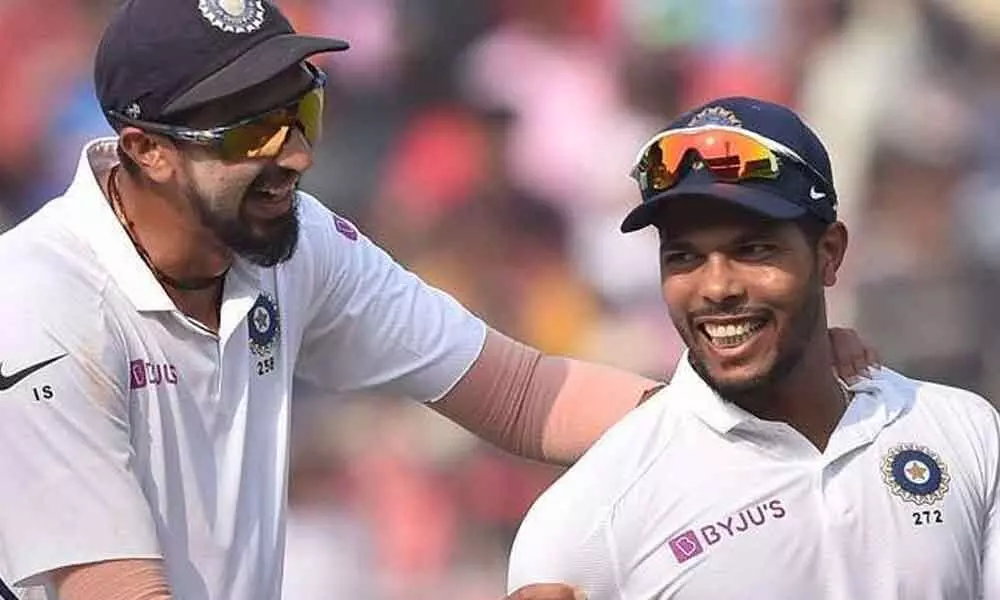Ishant's restrictive bowling or Umesh's attacking instinct?

Ishant Sharma's immense experience might gain precedence over Umesh Yadav's classical outswingers when Indian team management zeroes in on an injured Mohammed Siraj's replacement for the series-deciding final Test against South Africa.
Ishant Sharma's immense experience might gain precedence over Umesh Yadav's classical outswingers when Indian team management zeroes in on an injured Mohammed Siraj's replacement for the series-deciding final Test against South Africa.
Siraj, who sustained a hamstring strain while bowling on the first evening of the second Test, managed only 15.5 overs in the two innings and coach Rahul Dravid admitted that his injury did affect the team strategy while defending 240 in the fourth innings. Dravid had said that it is difficult to commit whether Siraj will get fit in next few days as hamstring injuries don't heal that easily. They require extensive rest and rehabilitation, more so for fast bowlers, who have way more workload than batters.
In this backdrop, India have two options for the Newlands Test starting January 11. One is 33-year-old Ishant, who hasn't been in the best of forms but has experience of more than 100 Tests and is a workhorse. The other is 34-year old Umesh, who has 51 Tests under his belt and in the recent past has been a better performer than Ishant, who seemed to have also lost out on a bit of pace with age catching up.
However both Dravid and skipper Virat Kohli, who everyone expects would make a comeback from his back injury in the final game, may prefer the lanky Delhi speedster for multiple reasons. One of the biggest reasons could be his near 6 feet 3 and half inch height, which might help in creating those awkward lengths for the Proteas batters, something that the home team pacers like Marco Jansen and Duanne Olivier have enjoyed.
"It just felt like the ball seemed to misbehave a little bit more for them, and that could be [because of the] fact of the height. On up-and-down wickets sometimes just having that extra height might tend to make a little bit of a difference, so it just felt for us [that] the balls didn't misbehave as much," Dravid had said.
Even former chairman of selectors MSK Prasad agreed that Ishant should be the choice. "We missed a tall fast bowler in Johannesburg and the only one we have is Ishant. On these kinds of tracks, he is my choice ahead of Umesh. Had it been an Indian track which is rugged and feels like dustbowl, Umesh would be my 'go to' man."
The ideal length on South African tracks is somewhere in between back of the length (short) and good length (6 metre). It's indeed a tricky one says former India keeper Deep Dasgupta, who feels that despite Ishant going off the boil in past few games, he still should be preferred at Newlands. "I won't be able to say whether Kohli has the same faith in Ishant's abilities which he had till 2019. But even then in this game, Ishant, if played, could come in handy compared to Umesh.
"Firstly, with that height, he would hit tougher lengths and secondly because of his ability to keep the batters quiet for long periods of time which unfortunately didn't happen on a bowler friendly track at the Wanderers," Dasgupta told PTI. "Ishant can bowl a good eight to 10 over spell and if we see the trend, a first innings score of 275 is the new 350 in Test matches in these conditions.
"Also Ishant bowls that fourth stump line where the ball can straighten or cut back enough to make the batters play. But yes, team management will check out their practice form too," Dasgupta. In case of Umesh, he bowls a fuller length, gets that lethal outswing going his way at 140 clicks but the question is, if India can afford to play a bowler, who has a propensity to bowl too many boundary balls. This habit of Umesh could prove to be very costly in low-scoring games where periods of lull created by defensive bowlers are like gold dust.
Effect of high tide and low tide
Just like at the erstwhile WACA ground in Perth where the afternoon sessions used to help the swing bowlers with lateral movement due to the 'Freemantle Doctor' -- afternoon sea breeze that blew across the ground --, some of the sessions at Cape Town are guided by the effect of High and Low Tides, assessed Dasgupta, who had played here in 2002.
"Newlands Stadium is beside the sea and there are times when there is a High Tide and in that case, there is more movement in the air and off the pitch available. "This is because when tide is high, the temperature gets a bit cooler and hence there is some amount of nip in the air. Exactly opposite happens in case of a low tide when it becomes a bit warmer and there might not be much for the bowlers. "In both cases, Ishant is a better bet to bowl attacking or defensive as per team's needs," Dasgupta said.



















